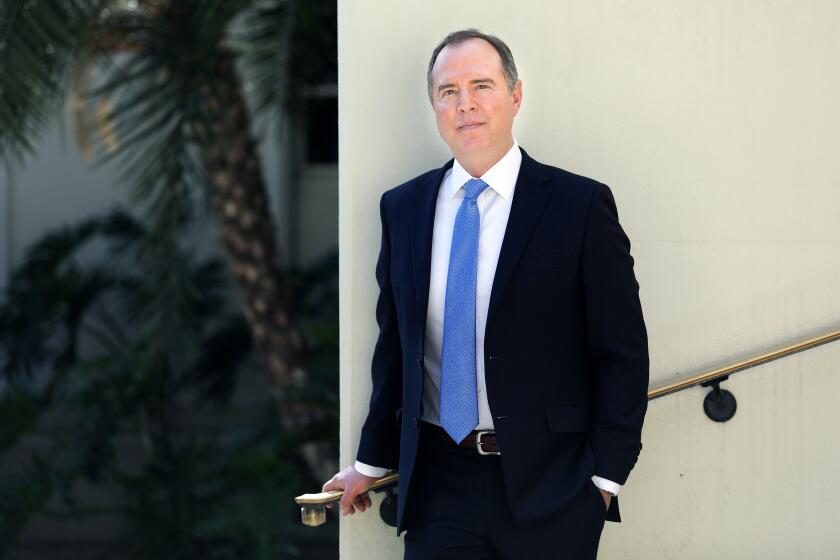It’s not just coronavirus: America repeatedly fails at public health

- Share via
WASHINGTON — As the coronavirus outbreak swept the country, President Trump for months promised high-tech solutions just over the horizon: thousands of new ventilators, miracle drugs and vaccines developed at “warp speed.”
He has shown decidedly less enthusiasm for simpler steps such as mask wearing and social distancing. That has frustrated public health officials, who are now pleading with Americans to make a few small changes in their behaviors to help control the widening pandemic.
But if the president’s disdain for masks may be extreme, his impulse to look for the latest and greatest medical intervention reflects a strong tradition in American healthcare that has long put a premium on new drugs, bigger medical systems and more technology, often at the expense of public health initiatives that other nations have shown to be more effective at lower cost.
“We are much more willing to put money toward treating something than preventing it,” said Dr. Richard Besser, the former acting director of the U.S. Centers for Disease Control and Prevention who now heads the Robert Wood Johnson Foundation.
It is a mindset that helps explain the nation’s more than $3.6-trillion annual healthcare tab, by far the highest in the world.
It also accounts for some of America’s struggles with the current pandemic, which is exploding across the country, threatening to claim tens of thousands of additional lives, even as it fades in Europe and other wealthy nations.
Similarly, the long-standing American resistance to public health measures hampers efforts to restrain diabetes, heart disease and other chronic illnesses that are driving hundreds of billions of dollars of medical spending.
“Public health is a quintessential public action,” said Dr. David Blumenthal, president of the New York-based Commonwealth Fund, which studies health systems in the U.S. and abroad. “It must be done by people working together on behalf of themselves and others. In a fiercely independent culture, that is very hard to undertake.”
America spends more than $237 billion a year on medical care for people with diabetes, for example, much of it to control a disease that can be prevented or managed with simple interventions like eating more healthful foods.
Just the tab for prescription drugs to control the disease topped $85 billion in 2017, according to research by the American Diabetes Assn.
By contrast, efforts by public health advocates, nutrition experts, pediatricians and others to strengthen dietary standards or create more incentives for healthful eating have run into persistent barriers, stymieing such initiatives for decades.
“There has long been this double standard when it comes to public health,” said John Auerbach, president of the nonprofit Trust for America’s Health. “If there is a new medicine, there is just an assumption that it will get paid for, no matter the cost. But every public health policy requires a cost-benefit analysis that must show it not only improves health but saves money.”
Even the structure of the American healthcare system tends to favor high-cost interventions such as surgery and treatment by specialists like endocrinologists, orthopedists and cardiologists, rather than primary-care physicians who traditionally helped patients maintain their health and prevent disease.
Nationally, the U.S. devotes on average only about 5% to 7% of total healthcare spending to primary care, even though there is growing evidence that places that have stronger primary care systems have healthier populations and lower overall healthcare costs.
Other wealthy nations invest up to twice as much on primary-care services and have substantially lower overall healthcare spending.
The U.S. spent more than $10,000 per person on healthcare in 2018, more than double what major European nations such as France, Britain and the Netherlands spend, according to data compiled by the Organization for Economic Cooperation and Development.
The roots of these imbalances run deep in American healthcare, dating back to efforts by physicians in the early 20th century to maintain control of medical care against a rising public health movement championed by government reformers.
As healthcare in America became big business, creating what the editor of the New England Journal of Medicine in 1980 called a “medical industrial complex,” drugmakers, medical systems, dialysis companies and others dependent on high medical spending expanded their influence.
And while medical spending in the U.S. rocketed upward, wariness of government helped check any parallel expansion in public health.
“Americans have been much more comfortable allowing money to flow to the private sector rather than go to the public sector,” said Blumenthal of the Commonwealth Fund.
Since the 2008-09 recession, the Trust for America’s Public Health has estimated that nearly 60,000 state and local public health jobs have been lost as investment in public health flagged.
Meanwhile, even small efforts to tackle public health challenges like removing sodas and junk food from school vending machines have proved to be monumental tasks requiring years of advocacy.
Auerbach, who was Boston health commissioner before taking the helm at the Trust for America’s Health, called the push to limit smoking in restaurants in the 1990s “one of the most difficult fights I’ve been involved in in 30 years in public health.” Today, the reduction in smoking stands as one of the great public health success stories in the U.S.
Even victories have sometimes proved ephemeral, however.
Although the Obama administration in 2012 issued rules setting standards for less salt and more whole grains in school meals, the Trump administration has been working since 2017 to roll back the rules under pressure from the food industry.
“It’s just ridiculous,” said Colin Schwartz, deputy director of federal affairs at the nonprofit Center for Science in the Public Interest, which spent years pushing for the food standards. “The evidence is clear that strong standards reduce obesity and set kids up for better health long-term, but they are obviously not looking long-term.”
Today, there is growing consensus among experts and healthcare leaders that combating chronic illnesses such as diabetes and heart disease — and controlling costs — will require even more robust public health interventions.
These include new efforts to tackle underlying causes of poor health, such as poverty, inadequate housing and education and poor childcare, areas where the U.S. has also under-invested over the years.
“We need to go upstream,” said George Halvorson, the former chief executive of Kaiser Permanente who now chairs First 5 California, an ambitious state effort to improve early childhood education and development.
Besser, the former acting CDC director, warned that the country’s inability to address these issues and build an adequate safety net is also now complicating the effort to control the coronavirus.
“We don’t have the social contract we need,” he noted. “It’s much harder to be successful in America because we don’t believe everyone deserves things such as health insurance, jobs that pay a living wage and sick leave. These things are not available to tens of millions of people of America. … and so, it’s harder for people to do the right thing.”
More to Read
Get the L.A. Times Politics newsletter
Deeply reported insights into legislation, politics and policy from Sacramento, Washington and beyond. In your inbox three times per week.
You may occasionally receive promotional content from the Los Angeles Times.











